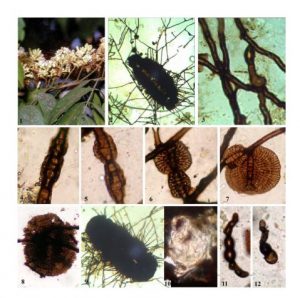Cirsosia humboldtigena Lini K. Mathew, Neeta N. Nair and Swapna S. sp. nov.,
Index Fungorum number: IF 552781; Faceoffungi number:FoF 02913;
Etymology : named after the host genus, Humboldtia.
Colonies hypophyllous, dense, black, up to 2 mm in diam. Hyphae straight to undulate, brown, branching alternate to opposite to irregular at acute angles, loosely reticulate, cells 38–50 ×2.4–4.8 µm. Appressoria intercalary, ovate, often slightly laterally, 2.6–5.4 µm in diam. Thyriothecia scattered, initially round and ovate, elongated at maturity with a longitudinal slit at the centre, 200–480 × 150–280 µm, margin crenate to fimbriate, fringed hyphae straight, closely aggregated and parallel, devoid of intercalary appressoria. Asci numerous, globose, octosporous, 30–42 µm in diam. Ascospores obovate, conglobate, uniseptate, deeply constricted at the septum, cinnamon-brown, 19–21 × 13–15 µm, wall echinulate. Pycnothyria many, similar to thyriothecia; pycnothyriospores deep brown, pyriform, slightly papillate, 17–19 × 11–13 µm.
Material examined – India, Kerala, Kozhikode, Malabar Wildlife Sanctuary, Janakikadu, on living leaves of Humboldtia vahliana (Caesalpiniaceae), 15 Oct 2013, Lini K. Mathew, MTCHT 77 (holotype)
Fig 1. Cirsosia humboldtigena sp. nov. 1. Infected leaves of Humboldtia vahliana, 2. Colony with thyriothecia, 3. Mycelium with intercalary appressoria, 4–8. Different stages of development of thyriothecia, 9. Mature thyriothecium, 10. Ascus. 11–12. Germinating ascospores
Species

